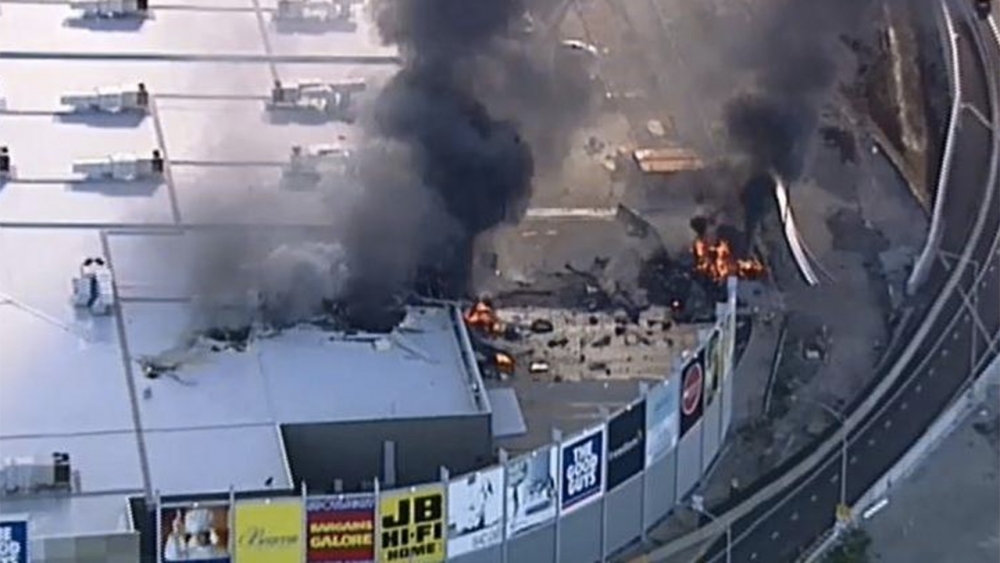The pilot of a charter aircraft involved in a fiery crash in a Melbourne shopping centre on Tuesday did not give details of the emergency as he called out “mayday’’ several times while the plane veered to the left.
Initial reports indicated the aircraft suffered a catastrophic engine failure but air safety investigators are keeping an open mind about the reasons for the crash. This is because aviation accidents are often the result of a combination of factors rather than a single cause.
Facing reporters in Melbourne on Wednesday, Australian Transport Safety Bureau chief Greg Hood said investigators would look extensively at all possible causal factors behind the accident.
“That includes maintenance records, the history of the aeroplane, the history of the pilot, the weight and balance,’’ he said. “*It involves previous accidents in relation to the Super King Air, for example, so at this very early stage certainly we’re not going to speculate in relation to any specific part of the investigation.’’
Five people died and freeways were closed after the plane exploded when it hit the closed DFO shopping centre next to Essendon Airport. Killed were veteran charter pilot Max Quartermain as well as US tourists and golfers Greg DeHaven, Glenn Garland, Russell Munsch and John Washburn, all from Texas.
Whitehouse press secretary Sean Spicer acknowledged the crash during a Press briefing on Tuesday.
"The president's thoughts and prayers are with the families of the victims and the US embassy and consulate are ready to provide necessary and appropriate assistance,’’ Spicer said.
The ATSB on Wednesday had four investigators on the ground in Melbourne and Hood said the aim was to issue a preliminary factual report on the crash within 28 days.
The investigators — whose backgrounds include aeronautical investigations, flight operations and mechanical engineering — are likely to remain on site for the next few days gathering evidence which will then undergo a forensic examination and analysis likely to take months to complete.
They already have more than 100 people on their witness list and will be collecting evidence such as footage from dash-cams from cars on the highway that could show features of the aircraft such as whether the undercarriage was deployed.
Hood said the Super King Air had taxied out to a southern runway out for a take-off at 8.30am and started a take-off roll at 8.59am.
Not long after Quartermain issued a mayday as the aircraft veered left and hit the shopping centre.
“My understanding is he didn’t refer to the specific nature of the emergency and he declared the mayday and said that word a number of times,’’ Hood said. “ Obviously, that can relate to a number of things that can go wrong in that aeroplane.’'
Questions have been raised about why Quartermain did not continue to climb if only one engine failed and Hood agreed modern twin-engine aircraft were designed to do this.
The plane also began veering to the left shortly after take-off and when asked if this would cause a loss in altitude that would have contributed to the crash, Hood said he was not sure he would characterise it that way.
“I’m not sure it was a sharp turn, in my observation it was a veer to the left rather than a sharp turn,’’ he said.
The ATSB chief also acknowledged media speculation about the pilot and his involvement in a reported breakdown of separation at Mt Hotham in September, 2015.
The ATSB investigated the incident but has yet to issue a report and Hood said he was not specifically aware of the pilot’s history or the timeline for the Mt Hotham report’s release.
The Australian newspaper said at the time that a Sydney pilot had lodged an incident report that his plane and the King Air flown by Quartermain had come within 300ft vertically and one nautical mile of each other.
The report said that Quartermain was struggling with a faulty GPS in poor weather and did not appear to know where he was, saying he was in locations 20 nautical miles apart within a short period.
CASA put Quartermain through an instrument proficiency check after the incident which he passed on the second attempt. CASA sent one of its own staff to conduct the check rather than rely on a third party.
It also understood the aircraft recently underwent maintenance to correct a hydraulic problem.
However, Hood cautioned against making early assumptions about the crash.
“With any accident, particularly aviation accidents, we find that initially there are a number of factors which leap out at you,’’ he said. “The investigators are trained not to put any bias or any reliance on what is the obvious. It’s really important that when you’re investigating an aviation transport accident, for example, that you remain completely objective.
“So whilst in the initial walk through yesterday and the initial examination of records we’ve discovered some interesting facets, we really need to gather all the evidence and conduct the analysis before we would be able to say what might have caused the accident.’’
























